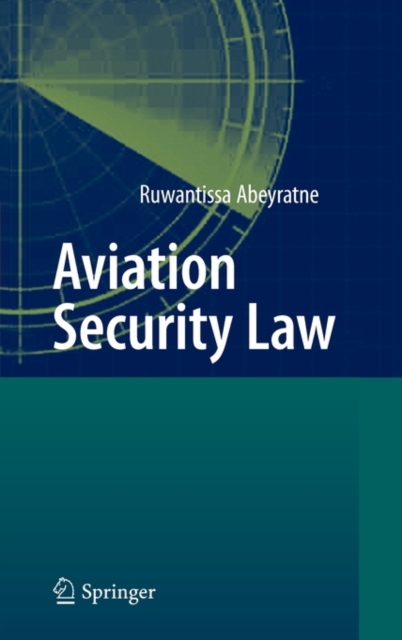
Aviation Security Law Hardback
by Ruwantissa Abeyratne
Hardback
Description
Aviation is an important global business and a signi?cant driver of the global economy.
Itisvital,therefore,thatstringentmeasuresaretakentocounteractsof unlawfulinterferencewithcivilaviation.
TheConventiononInternationalCivil AviationsignedatChicagoon7December1944,statesinitsPreamblethatwhereas thedevelopmentofcivilaviationmayhelppreservefriendshipandunderstanding amongthepeopleoftheworld,yet,itsabusecouldbecomeathreattogeneral security.
Thegenealogyoftheterm"Terrorism"liesinLatinterminologymeaning"to causetotremble"(terrere).
Sincethecatastrophiceventsof11September2001, we have seen stringent legal measures taken by the United States to attack terrorism,notjustcurbit.
Thefamousphrase"waronterror"denotespre-emptive andpreventivestrikescarriedoutthroughapplicableprovisionsoflegitimately adoptedprovisionsoflegislation.
TheearliestexampleistheAirTransportation Safety and System Stabilization Act (ATSAA)enactedbyPresidentBushless thantwomonthsafterthe9/11attacks.
Then,twomonthsaftertheattacks,in November2001,CongresspassedtheAviationandTransportationSecurityAct (ATSA)withaviewtoimprovingsecurityandclosingthesecurityloopholes whichexistedonthatfatefuldayinSeptember2001. Thelegislationpavedthe wayforahugefederalbodycalledtheTransportationSecurityAdministration (TSA) which was established within the Department of Transportation.
The HomelandSecurityActof2002whichfollowedeffectedasigni?cantreorga- zationoftheFederalGovernment.
Allthisgoestoshowthatthelawplaysasigni?cantroleinensuringaviation security.
Thisbookaddressesnewandemergingthreatstocivilaviation;evaluates securitytoolsnowinusesuchasthePublicKeyDirectory,AdvancePassenger Information,PassengerNameRecordandMachineReadabletraveldocumentsin the context of their legal and regulatory background; and discusses applicable securitytreatieswhileprovidinganinsightintotheprocessofthesecurityaudits conductedbytheInternationalCivilAviationOrganization(ICAO). v vi Preface ThebookalsoexaminesissuesoflegalresponsibilityofStatesandindividuals forterroristactsofthirdpartiesagainstcivilaviationanddiscussesfromalegal perspectivethelatestliabilityConventionsadoptedatICAO.
TheConclusionof thebookprovidesaninsightintotheapplicationoflegalprinciplesthroughrisk management. Sincethewritingofthisbook,theauthor publishedthreefeature articles entitled, The NW Flight 253 and the Global Framework of Aviation Security(AirandSpaceLaw,Volume35Issue2April2010167-Aviation is an important global business and a signi?cant driver of the global economy.
Itisvital,therefore,thatstringentmeasuresaretakentocounteractsof unlawfulinterferencewithcivilaviation.
TheConventiononInternationalCivil AviationsignedatChicagoon7December1944,statesinitsPreamblethatwhereas thedevelopmentofcivilaviationmayhelppreservefriendshipandunderstanding amongthepeopleoftheworld,yet,itsabusecouldbecomeathreattogeneral security.
Thegenealogyoftheterm"Terrorism"liesinLatinterminologymeaning"to causetotremble"(terrere).
Sincethecatastrophiceventsof11September2001, we have seen stringent legal measures taken by the United States to attack terrorism,notjustcurbit.
Thefamousphrase"waronterror"denotespre-emptive andpreventivestrikescarriedoutthroughapplicableprovisionsoflegitimately adoptedprovisionsoflegislation.
TheearliestexampleistheAirTransportation Safety and System Stabilization Act (ATSAA)enactedbyPresidentBushless thantwomonthsafterthe9/11attacks. Then,twomonthsaftertheattacks,in November2001,CongresspassedtheAviationandTransportationSecurityAct (ATSA)withaviewtoimprovingsecurityandclosingthesecurityloopholes whichexistedonthatfatefuldayinSeptember2001.
Thelegislationpavedthe wayforahugefederalbodycalledtheTransportationSecurityAdministration (TSA) which was established within the Department of Transportation.
The HomelandSecurityActof2002whichfollowedeffectedasigni?cantreorga- zationoftheFederalGovernment.
Allthisgoestoshowthatthelawplaysasigni?cantroleinensuringaviation security.
Thisbookaddressesnewandemergingthreatstocivilaviation;evaluates securitytoolsnowinusesuchasthePublicKeyDirectory,AdvancePassenger Information,PassengerNameRecordandMachineReadabletraveldocumentsin the context of their legal and regulatory background; and discusses applicable securitytreatieswhileprovidinganinsightintotheprocessofthesecurityaudits conductedbytheInternationalCivilAviationOrganization(ICAO). v vi Preface ThebookalsoexaminesissuesoflegalresponsibilityofStatesandindividuals forterroristactsofthirdpartiesagainstcivilaviationanddiscussesfromalegal perspectivethelatestliabilityConventionsadoptedatICAO. TheConclusionof thebookprovidesaninsightintotheapplicationoflegalprinciplesthroughrisk management.
Sincethewritingofthisbook,theauthor publishedthreefeature articles entitled, The NW Flight 253 and the Global Framework of Aviation Security(AirandSpaceLaw,Volume35Issue2April2010167-182);TheUse of Full Body Scanners and Their Legal Implications; and The Use of Forged PassportsforActsofCriminality(bothofwhichcouldbeaccessedthroughthe webpageoftheJournalofTransportationSecurity(Springer).
Thesethreearticles formausefuladjuncttothisbook. Montreal,CA RuwantissaAbeyratne Contents 1 ASecurityCulture ...1 A.
ARisk-BasedApproach ...1 B. TheICAOResponse ...2 I. TheICAOHigh-LevelMinisterialConference ...2 II. PostConferenceWork ...7 C. EmergingThreats ...9 I. Probability ...9 II. ReactingtoProbability ...10 III. Deterrence ...13 IV. ProblemsofDeterrence ...14 V. ThreatAssessmentinICAO ...16 VI. TheAVSECPanel ...19 VII. Bioterrorism ...21 VIII. Cyber-Terrorism ...24 IX. MANPADS ...25 X. TheDiverseNatureofMissileAttacks ...29 XI. InstallationofanAnti-missileSystem ...32 XII. ThePerimeterGuard ...32 XIII. InternationalAccord ...33 XIV. OtherCurrentThreats ...36 References ...36 2 PrinciplesofResponsibility ...39 A.
StateResponsibility ...39 I. PrinciplesofStateResponsibility ...42 II. TheTheoryofComplicity ...42 III. MechanismsforExtraditionofOffenders: TheLockerbieCase ...43 IV.
TheCondonationTheory ...48 V. TheRoleofKnowledge ...51 vii viii Contents VI. Pro?lingofPassengers ...54 VII. AirportPro?ling ...55 VIII. Pro?lingandtheRightofPrivacy ...58 B. OtherAspectsofResponsibility ...61 I. PreludetotheRomeConventionof1952 ...61 II. TheRomeConventionof1952 ...66 C. TheRomeConventionof1952 ...70 I. Background ...70 II. Insurance ...71 III. ProvisionsoftheConvention ...
Information
-
Out of stock
- Format:Hardback
- Pages:287 pages, XII, 287 p.; XII, 287 p.
- Publisher:Springer-Verlag Berlin and Heidelberg GmbH & Co. K
- Publication Date:30/06/2010
- Category:
- ISBN:9783642117015
Other Formats
- PDF from £76.08
- Paperback / softback from £95.55
Information
-
Out of stock
- Format:Hardback
- Pages:287 pages, XII, 287 p.; XII, 287 p.
- Publisher:Springer-Verlag Berlin and Heidelberg GmbH & Co. K
- Publication Date:30/06/2010
- Category:
- ISBN:9783642117015






